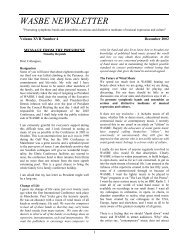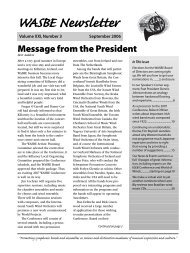March 2011 - World Association for Symphonic Bands and Ensembles
March 2011 - World Association for Symphonic Bands and Ensembles
March 2011 - World Association for Symphonic Bands and Ensembles
Create successful ePaper yourself
Turn your PDF publications into a flip-book with our unique Google optimized e-Paper software.
FOCUS ON HISTORY<br />
Jean Absil <strong>and</strong> the Wind B<strong>and</strong><br />
by Francis Pieters<br />
No doubt, Jean Absil (1893–1974) was<br />
one of the great characters of the Belgian<br />
music scene in the twentieth century. Un<strong>for</strong>tunately,<br />
Belgium is a small country <strong>and</strong><br />
Absil did not really break through on the<br />
international scene. Yet his output was<br />
rather vast, including five symphonies, three<br />
piano concertos, two violin concertos, an<br />
opera <strong>and</strong> a lot of orchestral <strong>and</strong> chamber<br />
music. He also set his stamp on the Belgian<br />
Wind B<strong>and</strong> music <strong>and</strong> certainly deserves to<br />
be brought to your notice.<br />
Jean Absil was born on October 23, 1893<br />
at Bonsecours, a hamlet of the municipality<br />
of Péruwelz in the Province of Hainaut in<br />
Belgium, close to the French border. At the<br />
age of seven, he<br />
got his first music<br />
lessons from his<br />
father, sexton at<br />
the local basilica<br />
church 1 . Sometime<br />
later, he studied<br />
with the organist<br />
of the basilica <strong>and</strong><br />
conductor of the<br />
local Wind B<strong>and</strong><br />
“Royale Fanfare<br />
Communale”,<br />
Absil as a young man.<br />
Alphonse Van<br />
Oeyen, a pupil of Edgar Tinel 2 . While<br />
studying harmony <strong>and</strong> learning to play the<br />
piano with Van Oeyen, young Absil also<br />
learned to play the flugelhorn <strong>and</strong> soon<br />
joined the local Fanfare B<strong>and</strong> at the desk of<br />
the third flugelhorn players 3 . As a compensation<br />
<strong>for</strong> the lessons he got from Van<br />
Oeyen, Jean Absil, aged 15 at that time, had<br />
to teach solfeggio to the members of the<br />
Wind B<strong>and</strong>. At the b<strong>and</strong> rehearsals, he never<br />
hesitated to replace absent musicians, as he<br />
also managed to play the trumpet, the<br />
French horn or the baritone horn reasonably<br />
well. All his life, Absil remained proud of<br />
those capacities <strong>and</strong> when, twelve years later<br />
in 1920, he submitted his first symphonic<br />
endeavors to his teacher Paul Gilson, the<br />
latter remarked: “You have played in a<br />
Wind B<strong>and</strong> as I immediately noticed when I<br />
read the brass parts.” When he was 20 years<br />
old, Jean Absil applied to be admitted at the<br />
Royal Brussels Conservatory of Music <strong>and</strong><br />
though the director Léon Dubois judged him<br />
too young, he was luckily admitted by intercession.<br />
He studied the organ with Alphonse<br />
Desmet, the piano with Raymond Moulaert<br />
<strong>and</strong> harmony with Edouard Samuel <strong>and</strong><br />
Martin Lunssens. In 1915, during <strong>World</strong> War<br />
I, he went weekly on foot to Brussels,<br />
walking 50 kilometers (33 miles) spread over<br />
three days. In the end, he was obliged to<br />
settle in the capital. In the meantime, he had<br />
obtained first prizes <strong>for</strong> organ <strong>and</strong> harmony.<br />
In order to earn a living, Absil played the<br />
piano <strong>and</strong> the harmonium in several caférestaurants<br />
<strong>and</strong> cinemas at Brussels <strong>and</strong><br />
continued to study. Still during the war, he<br />
obtained first prizes <strong>for</strong> counterpoint <strong>and</strong><br />
fugue. After the war he went to study<br />
composition <strong>and</strong> orchestration with the<br />
composer Paul Gilson, commonly called<br />
“The Father of Belgian Wind B<strong>and</strong> Music” 4 .<br />
No wonder that, through his contacts with<br />
Gilson, Absil also got a real weakness <strong>for</strong><br />
Wind <strong>B<strong>and</strong>s</strong>. Though, whereas Gilson clearly<br />
preferred the Fanfare B<strong>and</strong>, Jean Absil<br />
resolutely opted <strong>for</strong> the <strong>Symphonic</strong> B<strong>and</strong><br />
(orchestre d’harmonie). In 1921, Jean Absil<br />
was awarded the Second ‘Gr<strong>and</strong> Prix de<br />
Rome’ <strong>for</strong> his cantata La Guerre (The War),<br />
based on a text by Valère Gilles. This prize<br />
allowed him to become director of the<br />
music academy of Etterbeek (Brussels), one<br />
year later. In 1930 he was appointed<br />
professor of practical harmony at the Royal<br />
Brussels Conservatory of Music <strong>and</strong> <strong>for</strong><br />
many years he educated numerous gifted<br />
pupils, including several talented composers<br />
such as Jacques Leduc 5 <strong>and</strong> Victor Legley<br />
(cf. footnote 12). In late 1934, Absil was<br />
awarded the ‘Rubens Prize’ <strong>for</strong> his entire<br />
musical production. With the prize money<br />
Absil went to Paris in early 1935 <strong>and</strong> met,<br />
among others, the French composer Florent<br />
Schmitt with whom he became friends. This<br />
meeting deeply influenced Absil’s future <strong>and</strong><br />
gave him more self confidence. Back in his<br />
home country, Absil brought together<br />
several young composers (René Bernier,<br />
Raymond Chevreuille, Charles Hens, Albert<br />
Huybrechts, Marcel Poot, Maurice Schoemaker,<br />
André Souris <strong>and</strong> Jef Van Durme) <strong>and</strong><br />
established an association called “La Sirène”<br />
which aimed at the promotion of contemporary<br />
music <strong>and</strong> tried to organize concerts<br />
both in Belgium <strong>and</strong> abroad. This association<br />
subsisted until 1938 <strong>and</strong> its periodical<br />
“Syrinx” until one year later. In 1937 Absil<br />
published “Postulats de la Musique<br />
Contemporaine” (Postulates of contemporary<br />
music), prefaced by Darius Milhaud,<br />
<strong>and</strong> one year later, in 1938, he created the<br />
“Revue Internationale de Musique” which<br />
was published until 1940. It was his first<br />
“Piano Concerto” opus 30, written <strong>for</strong> the<br />
Ysaÿe competition 6 that helped Absil to gain<br />
some international notice in 1938 7 . In 1939<br />
he was invited to teach fugue at the Royal<br />
Brussels Conservatory of Music <strong>and</strong>, that<br />
very same year, Queen (mother) Elisabeth<br />
asked him to teach counterpoint <strong>and</strong> fugue<br />
at the newly founded “Chapelle Reine<br />
Elisabeth” 8 . In 1945, Jean Absil became the<br />
very first manager <strong>and</strong> president of SABAM,<br />
the Belgian Society of Authors, Composers<br />
<strong>and</strong> Publishers. His major concern was to get<br />
affiliated all French speaking authors <strong>and</strong><br />
composers of the country, as up to that time<br />
they had been members of the SACEM, the<br />
French Society of Authors, Composers <strong>and</strong><br />
Publishers. The job was rather fastidious <strong>and</strong><br />
finally Absil resigned in May 1948. He had<br />
done a great job <strong>and</strong>, in the end, Belgium<br />
got a fine composer back. Indeed, Absil<br />
developed a quite personal style <strong>and</strong> his<br />
enormous creative power resulted in a huge<br />
output. He denied several of his early works<br />
though many turned out to be very interesting.<br />
He composed five symphonies,<br />
numerous orchestral pieces, concertos, piano<br />
music, chamber music <strong>and</strong> also a lot of vocal<br />
music. For over 40 years he was director of<br />
the Etterbeek Music Academy which was<br />
named after him “Jean Absil Music<br />
Academy” in 1963. He was awarded the<br />
20 WASBE <strong>World</strong>


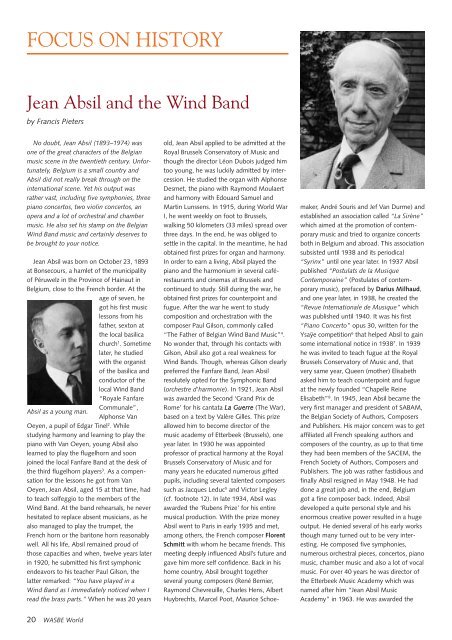
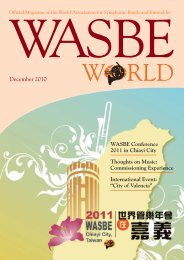
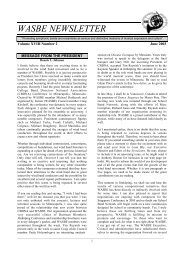

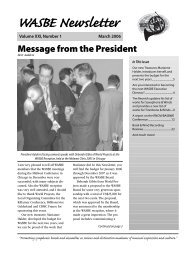
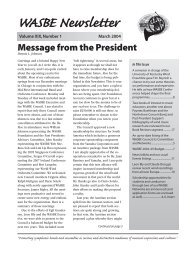

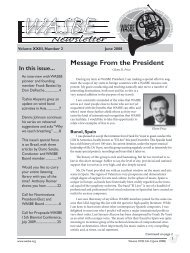
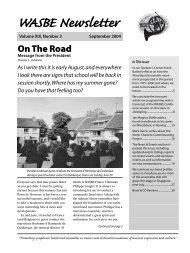
![application form [PDF; 110K]](https://img.yumpu.com/37266203/1/190x253/application-form-pdf-110k.jpg?quality=85)
